|
Proven Lures &
Presentations for Smallmouths
Part 1: Jigs, Tube Jigs, Grubs, Carolina Rigs
by
Mark Hicks |
| A BOAT
LOAD of useful walleye information in each issue
from seasoned tournament fishermen and Lake Erie fishing experts. |
|
Lake Erie Walleye Magazine
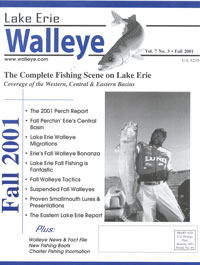
Subscribe HERE
More Information HERE
|
|
Before Zebra Mussels invaded Lake
Erie and drastically increased its water clarity, smallmouth anglers who
preferred lures over live bait were practically limited to jigs. In the murky
water, which was especially prominent in the western basin, bass relied more on
their sense 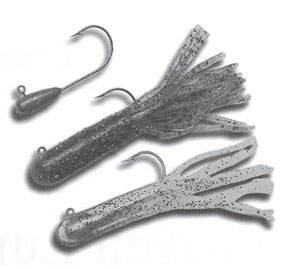 of
sound to find food than their eyes. They could more easily locate a darkly
colored jig scratching along the bottom than a flashing lure darting overhead.
of
sound to find food than their eyes. They could more easily locate a darkly
colored jig scratching along the bottom than a flashing lure darting overhead.
Now that Erie has become dramatically clearer, its smallmouths see prey
farther away. The bass now move greater distances to pounce on a meal or lure.
This opens the door to a gamut of lures that take smallnouth bass from top to
bottom. The key is matching the lure to the season and the conditions.
JIGS
Even though Lake Erieís smallmouths are now susceptible to a variety of
lures, jigs still rank No. 1. For decades, the preferred Lake Erie smallmouth
lure was a black or gray bucktail jig. Bucktail jigs continue to fare well, but
they were nudged out of the top spot by jigs dressed with curly-tailed grubs.
When plastic tube jigs found their way to Lake Erie, the response among
smallmouth anglers resembled a mob scene at a rock concert. The enthusiasm for
this lure has not diminished since.
TUBE JIGS
If you were limited to one lure for Lake Erie smallmouths, it would have to
be a tube jig. Tubes take bass of all sizes throughout the season and often in
greater numbers than any other lure. During a recent fall B.A.S.S. Federation
Divisional tournament held in the western basin, teams of  anglers
from nine states and the country of Italy crushed every existing record for
Federation tournament catches.
anglers
from nine states and the country of Italy crushed every existing record for
Federation tournament catches.
Overall, the three-day event racked up 1,429 bass, 221 limits and a total
weight of 3,257 pounds of predominantly smallmouth bass. Lure selection for the
tournament fell into the category of "no brainer." So many of the
competitors caught their bass on tubes that it was practically a one-lure
tournament. The significant question was: What color tube are you using? For
most it was some shade of green or smoke.
Berkleyís Power Tube, the first lure of this type to establish itself on
Lake Erie, impressed many charter captains who previously 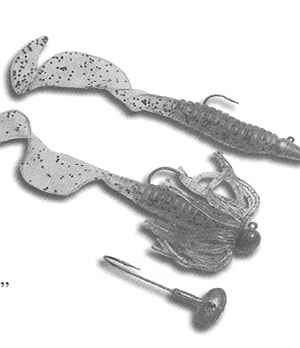 relied
only on live bait.
relied
only on live bait.
"The Power Tube," says Capt. Bob Troxel, "is the first lure Iíve
seen that competes head to head with live bait. Even clients who have little
fishing experience regularly catch bass on it."
Fat 3 1/2-inch tubes impregnated with salt, such as Kalinís Super Salty
Scented Tubes and Venomís Erie Series Tubes have proven to be just as
effective on Lake Erie smallmouths as Berkley Power tubes. The most popular
colors include chartreuse, watermelon and dark green, all with black flake.
Smoke and brown hues also score well. One reason tubes work so well is they
mimic the primary forage upon which Erieís smallmouths feed. Root a tube along
the bottom and it resembles a crayfish or a fat goby. Swim it above the bottom
and it appears to be a baitfish on the run.
Narrow jig heads, often in a teardrop shape, slide inside tubes and give
these lures a clean, uninterrupted appearance that smallmouths find inviting.
Jigs weighing from 1/8- to 3/4-ounce will handle anything Lake Eric throws at
you, with 1/4- and 3/8-ounce sizes being the work- horses.
Early in the season, New York smallmouth guide Jim Hanley rigs tubes with
3/8- and 1/2- ounce jigs and casts them to deep points where smallmouths stage
prior to spawning.
"If itís not too windy," says Hanley, "I hold the boat with
the electric motor and cast to the fish. Because the water is only in the upper
40s to low 50s, I want to keep the tubes on bottom and give them very little
movement. In early spring, I love clear silver flake and firecracker
colors."
Fishing guide Terry Jones, who works both the New York and Ontario waters of
the eastern basin, fishes tubes vertically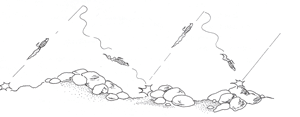 early in the season.
early in the season.
"When the bass are on the breaks," says Jones, "I stay right
on top of them with my trolling motor and drop a tube straight down to the
bottom."
As the water warms and bass move up to the tops of flats and humps, drifting
methods prevail. Many anglers fail to take full advantage of this phase because
they overwork their tubes. Jeff Snyder recommends that you drag tubes with a
long line that keeps them digging bottom. Hold the rod low and dead still.
"Just let the boat do the work," says Snyder.
"When Iím not fishing a tournament, I hold one rod in each hand. I 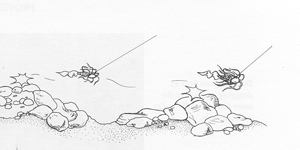 canít
tell you how many times Iíve hooked two bass at once.
canít
tell you how many times Iíve hooked two bass at once.
GRUBS
A jig dressed with an undulating curly- tailed grub is the runner-up to the
tube. A 3- inch grub was once the most popular size, but the 5-inch fat grub now
holds the position of prominence. Joe Thomas, of Cincinnati, Ohio, relied on
this lure to win a $ 1 00,000 purse during a Red Man All- American bass
tournament on eastern Lake Erie at Buffalo, New York.
"If youíre after big smallmouths," emphasizes Thomas, "youíll
score better with big grubs."
Thomas rigs a 5-inch Kalinís Salty Lunker Grub with a 1/4-ounce darter head
jig that has a long-shanked hook. The long shank is crucial for securing solid
hookups with these thick-bodied lures. After casting the grub and letting it
touch down, Thomas snaps it up, sharply about 3 feet off the bottom and
continues the jump- bump action all the way back.
"That big grub darting up brings out the smallmouthís aggressive
nature," Thomas believes. "They nail it on the fall."
Jeff Snyder, another proponent of the 5-inch Kalinís grub, threads the bait
on a 118- to 5/8-ounce football head jig. The wide, football head imparts a
stable swimming action and avoids snagging in boulders better than other jig
designs, especially with the drift-and-drag presentation that Snyder employs.
To give the jig even more bulk and animation, Snyder embellishes it with a
hula skirt which he slips onto the jigís collar before fixing the grub in
place. This combination is referred to as a spider jig.
Spider jigs almost seem too big a mouthful for smallmouths, but the bass
engulf them with relish. Snyderís most reliable colors are pumpkin-pepper,
pumpkin with green flake, avocado seed and chartreuse salt and pepper.
The most crucial facet to effectively dragging a grub is the amount of line
let out behind the drifting boat. Start by making a long cast into the wind.
Then hold the rod tip low and still. You should soon feel the jig ticking
bottom.
If the jig bangs into one boulder after another and tends to snag, reel in
until the bottom contact becomes less frequent. The jig should swim freely above
the bottom with only occasional contact.
CAROLINA RIG
Carolina rigs perform well for casting and drift-and-drag presentations. Put
together a basic Carolina rig by first threading 15-to 20-pound monofilament
from a stiff baitcasting outfit through a 1-ounce egg sinker. Tie the line to
one end of a swivel. To the other side of the swivel
attach a 3- to 5-foot leader comprised of 8- to 12-pound test monofilament.
The business end of the leader should sport a 2/0 or 3/0 worm hook dressed
with some type of soft plastic morsel.  Curly-tailed
grubs, 4- to 6-inch worms, tubes and reapers have all proven to be effective on
Lake Erie. Hanley especially likes Berkleyís Power Sand Worm. Rig the lures
Texas style, with the hookís point embedded into the plastic to make them snag
resistant.
Curly-tailed
grubs, 4- to 6-inch worms, tubes and reapers have all proven to be effective on
Lake Erie. Hanley especially likes Berkleyís Power Sand Worm. Rig the lures
Texas style, with the hookís point embedded into the plastic to make them snag
resistant.
A Carolina rigís heavy sinker beats a lively tattoo on Erieís rocky
bottoms. The ruckus brings smallmouth bass around to investigate, at which point
they find the plastic floating seductively behind. Itís usually an offering
they canít refuse. Many anglers place one or two 8mm glass beads above and
below the sinker to generate more noise. Thatís not a bad idea, because the
commotion caused by the heavy sinker banging against the bottom attracts fish.
"The more noise you make," says Hanley, "the more fish youíre
going to catch. Iíve seen many days when a Carolina rig out fishes anything
else. Iím convinced itís because the sinker rattles, pounds and bounces
along the bottom."
Another fishing guide who praises the Carolina rig is Greg Horoky, who works
out of Colchester, Ontario, in the western basin. Horoky is convinced that the
biggest srnallmouths suspend above bottom and prefer larger baits. To appeal to
these fish, Horoky and his friend Bill Gitlin developed Mannís Floating Jelly
Tube in 4- and 6-inch sizes.
This fat plastic lure dwarfs conventional tubes and comes packaged with
flotation inserts. The foam inserts make Floating Jelly Tubes float high off the
bottom when rigged Carolina style with a 3- to 6- foot leader. Since the lure
floats above bottom snags, Horoky rigs it with a straight-shanked 3/0 or 4/0
hook, tip exposed. He runs the hookís shank between the inside wall of the
tube and the foam insert and out the nose of the bait.
"Just drag the bait behind the boat," says Horoky. "When the
sinker hits and bounces off rocks, the tubes starts and stops and .....
......... to complete this article you must be an
active subscriber. With your subscription you'll
receive password access to the Subscribers Only web site where you can enjoy
hundreds of fishing articles from the current and past issues of the magazine,
all ONLINE. In addition you'll have Lake Erie Walleye Magazine
delivered to your home. All this for only $12.00/year.
Subscribe online here.
You can also call our toll free number at 1-800-347-4519
to subscribe today!

 of
sound to find food than their eyes. They could more easily locate a darkly
colored jig scratching along the bottom than a flashing lure darting overhead.
of
sound to find food than their eyes. They could more easily locate a darkly
colored jig scratching along the bottom than a flashing lure darting overhead. anglers
from nine states and the country of Italy crushed every existing record for
Federation tournament catches.
anglers
from nine states and the country of Italy crushed every existing record for
Federation tournament catches. relied
only on live bait.
relied
only on live bait. early in the season.
early in the season. canít
tell you how many times Iíve hooked two bass at once.
canít
tell you how many times Iíve hooked two bass at once. Curly-tailed
grubs, 4- to 6-inch worms, tubes and reapers have all proven to be effective on
Lake Erie. Hanley especially likes Berkleyís Power Sand Worm. Rig the lures
Texas style, with the hookís point embedded into the plastic to make them snag
resistant.
Curly-tailed
grubs, 4- to 6-inch worms, tubes and reapers have all proven to be effective on
Lake Erie. Hanley especially likes Berkleyís Power Sand Worm. Rig the lures
Texas style, with the hookís point embedded into the plastic to make them snag
resistant.